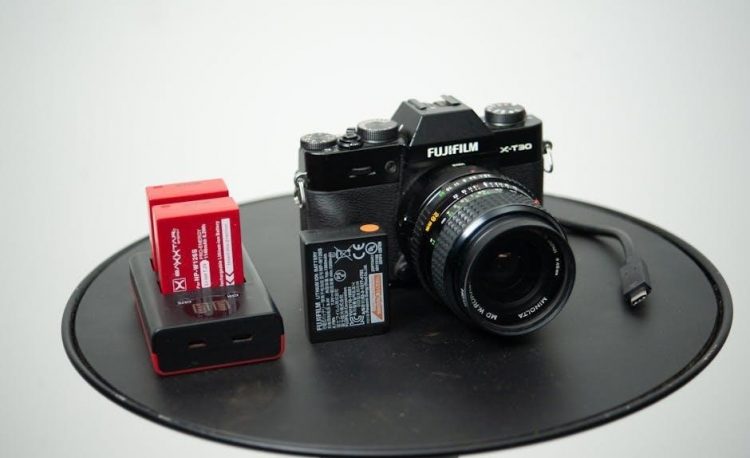The Nikon D70 Owner’s Manual is your gateway to understanding and mastering this iconic DSLR camera. This comprehensive guide covers everything from basic operations to advanced settings, ensuring you unlock the camera’s full potential. With detailed explanations and practical advice, it helps photographers of all levels troubleshoot issues, optimize image quality, and explore creative possibilities. Whether you’re a seasoned pro or a beginner, this manual is an indispensable resource for getting the most out of your Nikon D70.
Overview of the Nikon D70 DSLR Camera
The Nikon D70 is a groundbreaking 6.1-megapixel DSLR introduced in 2004, featuring a DX-format CCD image sensor for high-resolution photography. Designed for both professionals and enthusiasts, it offers compatibility with Nikon F-mount lenses, ensuring versatility. The camera boasts impressive ISO sensitivity, intuitive controls, and advanced shooting modes. Its durable construction and user-friendly interface make it a favorite among photographers. With features like manual exposure control and customizable settings, the D70 balances simplicity and sophistication, catering to a wide range of creative needs. It remains a reliable choice for capturing stunning images in various lighting conditions.
Importance of Reading the Owner’s Manual
Reading the Nikon D70 Owner’s Manual is essential for unlocking the camera’s full potential. This comprehensive guide provides detailed insights into the camera’s features, troubleshooting techniques, and optimal usage tips. It helps photographers of all skill levels understand the camera’s functions, from basic operations to advanced settings. The manual offers practical advice for improving image quality, customizing settings, and resolving common issues. Whether you’re a professional or a hobbyist, the manual serves as an indispensable resource for mastering the Nikon D70 and enhancing your photography skills. It ensures you make the most of your camera’s capabilities and capture stunning images effortlessly.

Key Features and Specifications of the Nikon D70
The Nikon D70 boasts a 6.1-megapixel DX-format CCD sensor, Nikon F-mount compatibility, RAW image support, ISO sensitivity up to 1600, and a burst mode of 3 frames per second.
6.1-Megapixel DX Format CCD Image Sensor
The Nikon D70’s 6.1-megapixel DX-format CCD image sensor delivers high-resolution images with vibrant colors and sharp details. Its compact size allows compatibility with DX lenses, optimizing performance and reducing vignetting; This sensor supports various shooting modes and ensures excellent image quality, even in challenging lighting conditions. Combined with Nikon’s advanced processing, it provides a balance of detail and dynamic range, making it suitable for both casual and professional photography needs.
Nikon F-Mount Compatibility
The Nikon D70 is compatible with the Nikon F-Mount, offering a wide range of lens options, including AF, AF-S, and older MF lenses. This versatility allows photographers to choose the best lens for their needs, from wide-angle to telephoto. The F-Mount ensures seamless communication between the camera and lens, enabling advanced features like autofocus and aperture control. While the D70’s DX-format sensor is optimized for DX lenses, it also supports FX lenses, providing flexibility for future upgrades. This compatibility enhances creativity and ensures the D70 remains a versatile tool for photographers of all levels.
ISO Sensitivity and Noise Performance
The Nikon D70 offers ISO sensitivity ranging from 200 to 1600, with an expanded option for ISO 6400. Lower ISO settings (200-400) provide optimal image quality with minimal noise, while higher ISOs (800-1600) introduce noticeable grain but enable shooting in low-light conditions. The camera performs well at higher ISOs compared to its contemporaries, making it suitable for a variety of lighting scenarios. Users can adjust ISO settings manually or rely on the camera’s AUTO ISO feature, though manual control is recommended for precise results. Balancing ISO with aperture and shutter speed ensures sharp, noise-free images, enhancing overall photography experience.

Getting Started with Your Nikon D70
Unpack and charge the battery, then insert it along with a memory card. Set the date, time, and language for proper camera functionality and photo organization.
Unpacking and Initial Setup
Begin by carefully unpacking the Nikon D70 and its accessories, ensuring all components are included and undamaged. Familiarize yourself with the camera’s exterior, including buttons, dials, and ports. Handle the camera with care to avoid damage. Insert the battery and charge it fully before first use. Install a compatible memory card, ensuring it is formatted correctly. Turn on the camera and navigate to the setup menu to configure the date, time, and language. Refer to the manual for detailed instructions on initial settings and menu navigation. Proper setup ensures optimal performance and prevents potential issues during use.
Inserting the Battery and Charging
Handle the EN-EL3 battery carefully to avoid damage. Insert the battery into the camera’s battery compartment, located in the grip, ensuring the terminals align correctly. Close the compartment securely. Use the MH-18a charger to charge the battery, with charging time approximately 2 hours. Avoid overcharging. The battery icon on the LCD indicates charge level. Charge the battery fully before first use. Store unused batteries in a cool, dry place, away from metal objects. Proper battery care ensures optimal performance and longevity. Always use Nikon-approved batteries and chargers to maintain camera functionality and safety. Follow manual guidelines for charging and handling.
Memory Card Installation and Management
Insert the CF card into the camera’s memory card slot, located on the right side, until it clicks into place. Use compatible CF cards (Type I/II or MicroDrive) with capacities up to 2GB. Format the card in the camera using the “Format” option in the menu to ensure proper functionality. Always turn the camera off before removing or inserting the card to prevent data loss; Use a card reader or the camera’s USB connection to transfer images to your computer. Regularly clean the card contacts with a soft cloth to maintain performance. Proper card management ensures reliable image storage and retrieval. Avoid using damaged or incompatible cards to prevent camera malfunctions. Follow the manual’s guidelines for optimal memory card use. Always back up your images to prevent data loss. Use high-quality cards to ensure optimal performance and image integrity. The D70 supports various CF card types, but avoid using cards with physical switches or locks unless specified. Format the card periodically to maintain its efficiency and prevent errors. Store cards in protective cases when not in use to avoid damage. Always handle cards carefully to prevent scratches or bending. The camera’s LCD will display the remaining card capacity, helping you manage storage effectively. Use the “Card” menu to view detailed information about the inserted card, including its capacity and format status. Proper card management is essential for smooth camera operation and image security. Always follow the manufacturer’s recommendations for CF cards to ensure compatibility and performance. Avoid using cards with low storage capacity for high-resolution images to prevent running out of space during shoots. Use a card reader with high transfer speeds for efficient image transfer. Clean the card contacts regularly to maintain proper communication between the card and camera. Never force a card into the slot, as this could damage both the card and the camera. Use the “Protect” feature to prevent accidental deletion of important images. Format the card in the camera rather than on a computer for consistent performance. Always verify the card’s compatibility with the D70 before purchasing or using it. Use the “Card” menu to check the card’s remaining capacity and format it when necessary. Proper memory card management ensures optimal performance, image quality, and reliability. Always store cards in a cool, dry place to prevent data corruption. Use a card with sufficient storage capacity for your shooting needs to avoid interruptions. Format the card immediately after purchasing to ensure it is ready for use. Avoid using cards that have been formatted by other devices to prevent compatibility issues. Use the camera’s built-in card management features to organize and protect your images. Always handle cards with clean, dry hands to prevent damage from moisture or static electricity. Use a high-quality card reader to ensure fast and reliable image transfer. Format the card periodically to maintain its performance and prevent errors. Store cards in a protective case when not in use to prevent physical damage. Always check the card’s remaining capacity before shooting to ensure you have enough space for your images. Use the “Card” menu to verify the card’s specifications and ensure it is compatible with the D70. Proper memory card management is crucial for maintaining image quality and camera functionality. Avoid using cards with physical damage or signs of wear to prevent data loss. Use a card with a high write speed to ensure fast image capture and processing. Format the card in the camera to ensure it is optimized for the D70’s file system. Always follow the manufacturer’s guidelines for CF cards to ensure compatibility and performance. Use the camera’s LCD to monitor the card’s remaining capacity and format it when necessary. Proper card management ensures reliable image storage and retrieval, allowing you to focus on capturing high-quality images. Always store cards in a cool, dry place to prevent data degradation. Use a high-quality card reader to ensure efficient image transfer to your computer. Format the card periodically to maintain its efficiency and prevent errors; Avoid using cards with low storage capacity for high-resolution images to prevent running out of space during shoots. Use the “Protect” feature to prevent accidental deletion of important images. Always handle cards carefully to avoid scratches or bending. Proper memory card management is essential for smooth camera operation and image security. Use the “Card” menu to view detailed information about the inserted card, including its capacity and format status. Always verify the card’s compatibility with the D70 before purchasing or using it. Use high-quality cards to ensure optimal performance and image integrity. Avoid using cards with physical switches or locks unless specified. Format the card in the camera rather than on a computer for consistent performance. Always check the card’s remaining capacity before shooting to ensure you have enough space for your images. Use a card with sufficient storage capacity for your shooting needs to avoid interruptions. Store cards in protective cases when not in use to avoid damage. Proper card management ensures optimal performance, image quality, and reliability. Always follow the manufacturer’s recommendations for CF cards to ensure compatibility and performance. Use the camera’s built-in card management features to organize and protect your images. Avoid using cards that have been formatted by other devices to prevent compatibility issues. Always turn the camera off before removing or inserting the card to prevent data loss. Use a card with a high write speed to ensure fast image capture and processing. Clean the card contacts regularly to maintain proper communication between the card and camera. Never force a card into the slot, as this could damage both the card and the camera. Use the “Card” menu to check the card’s remaining capacity and format it when necessary. Proper memory card management ensures optimal performance, image quality, and reliability. Always store cards in a cool, dry place to prevent data corruption. Use a high-quality card reader to ensure fast and reliable image transfer. Format the card periodically to maintain its performance and prevent errors. Store cards in a protective case when not in use to prevent physical damage. Always check the card’s remaining capacity before shooting to ensure you have enough space for your images. Use the “Card” menu to verify the card’s specifications and ensure it is compatible with the D70. Proper memory card management is crucial for maintaining image quality and camera functionality. Avoid using cards with physical damage or signs of wear to prevent data loss. Use a card with sufficient storage capacity for your shooting needs to avoid interruptions. Format the card immediately after purchasing to ensure it is ready for use. Always handle cards with clean, dry hands to prevent damage from moisture or static electricity. Use high-quality cards to ensure optimal performance and image integrity. Avoid using cards with physical switches or locks unless specified. Format the card in the camera rather than on a computer for consistent performance. Always verify the card’s compatibility with the D70 before purchasing or using it. Use the camera’s LCD to monitor the card’s remaining capacity and format it when necessary. Proper card management ensures reliable image storage and retrieval, allowing you to focus on capturing high-quality images. Always store cards in a cool, dry place to prevent data degradation. Use a high-quality card reader to ensure efficient image transfer to your computer. Format the card periodically to maintain its efficiency and prevent errors. Avoid using cards with low storage capacity for high-resolution images to prevent running out of space during shoots. Use the “Protect” feature to prevent accidental deletion of important images. Always handle cards carefully to avoid scratches or bending. Proper memory card management is essential for smooth camera operation and image security. Use the “Card” menu to view detailed information about the inserted card, including its capacity and format status. Always verify the card’s compatibility with the D70 before purchasing or using it. Use high-quality cards to ensure optimal performance and image integrity. Avoid using cards with physical switches or locks unless specified. Format the card in the camera rather than on a computer for consistent performance. Always check the card’s remaining capacity before shooting to ensure you have enough space for your images; Use a card with sufficient storage capacity for your shooting needs to avoid interruptions. Store cards in protective cases when not in use to avoid damage. Proper card management ensures optimal performance, image quality, and reliability. Always follow the manufacturer’s recommendations for CF cards to ensure compatibility and performance. Use the camera’s built-in card management features to organize and protect your images. Avoid using cards that have been formatted by other devices to prevent compatibility issues. Always turn the camera off before removing or inserting the card to prevent data loss. Use a card with a high write speed to ensure fast image capture and processing. Clean the card contacts regularly to maintain proper communication between the card and camera. Never force a card into the slot, as this could damage both the card and the camera. Use the “Card” menu to check the card’s remaining capacity and format it when necessary. Proper memory card management ensures optimal performance, image quality, and reliability. Always store cards in a cool, dry place to prevent data corruption. Use a high-quality card reader to ensure fast and reliable image transfer. Format the card periodically to maintain its performance and prevent errors. Store cards in a protective case when
Setting the Date, Time, and Language
Turn on the camera and navigate to the menu using the multi-selector. Select the “Setup” menu and choose “Date and Time.” Use the multi-selector to adjust the date, time, and format (YYYY/MM/DD or DD/MM/YYYY). Press the “OK” button to confirm; To set the language, go to the “Language” option in the same menu and select your preferred language from the list. Ensure the date and time are accurate for proper file naming and image organization. Refer to the manual for detailed steps if needed; Accurate settings ensure optimal camera functionality and user-friendly operation. Proper configuration is essential for seamless performance. Always verify the settings after adjustment.
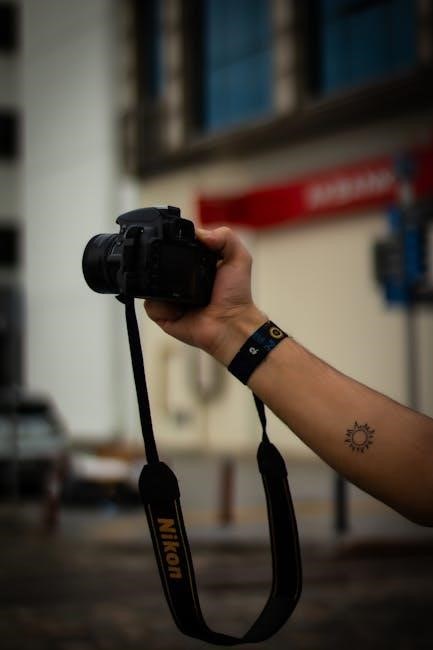
Basic Camera Operations
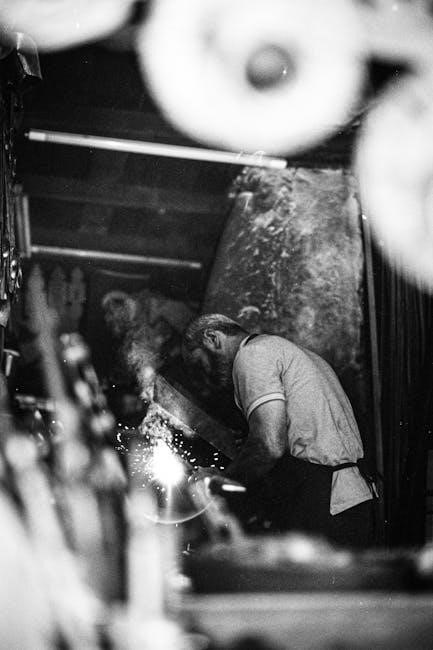
Master the fundamentals of the Nikon D70 with ease. Learn to navigate the mode dial, viewfinder, and LCD display for seamless shooting. Understand basic modes like Auto, P, S, A, and M to capture stunning images effortlessly. These essential operations form the foundation of your photography journey, ensuring every shot is precise and meaningful. Familiarize yourself with these basics to unlock the camera’s full potential and enhance your creative expression. Proper understanding of these operations is crucial for achieving optimal results in various shooting conditions.
Understanding the Mode Dial
The Nikon D70’s mode dial simplifies shooting by offering multiple presets for various scenarios. Auto mode handles everything for quick, hassle-free shots. Program Mode (P) gives you flexibility while the camera manages exposure. Shutter Priority (S) lets you set shutter speed to freeze or blur motion. Aperture Priority (A) allows control over aperture for depth of field. Manual Mode (M) offers full control for precise adjustments. Each mode is designed to cater to different skill levels and shooting conditions, ensuring you capture moments with ease and creativity. Familiarizing yourself with these modes enhances your photography experience and ensures optimal results.
Using the Viewfinder and LCD Display
The Nikon D70’s viewfinder provides a clear, 95% frame coverage for precise composition. It displays key shooting information like aperture, shutter speed, and ISO. The LCD screen complements the viewfinder by showing histogram, shooting data, and image playback. Use the viewfinder for stability and accurate framing, especially in bright light. The LCD is ideal for reviewing images and adjusting settings. Familiarize yourself with these tools to enhance your shooting experience. Proper use of both ensures you capture sharp, well-exposed photos with ease, making the D70 a versatile and reliable choice for photographers of all skill levels.
Basic Shooting Modes: Auto, P, S, A, M
The Nikon D70 offers five primary shooting modes to suit various photography needs. Auto mode simplifies photography by automatically adjusting settings. Program mode (P) allows customization while the camera manages exposure. Shutter Priority (S) lets you set shutter speed to freeze or blur motion. Aperture Priority (A) enables control over aperture for depth of field. Manual mode (M) gives full control over aperture and shutter speed for creative freedom. These modes cater to both beginners and advanced photographers, providing flexibility to adapt to different shooting scenarios and improve your photography skills with the D70.
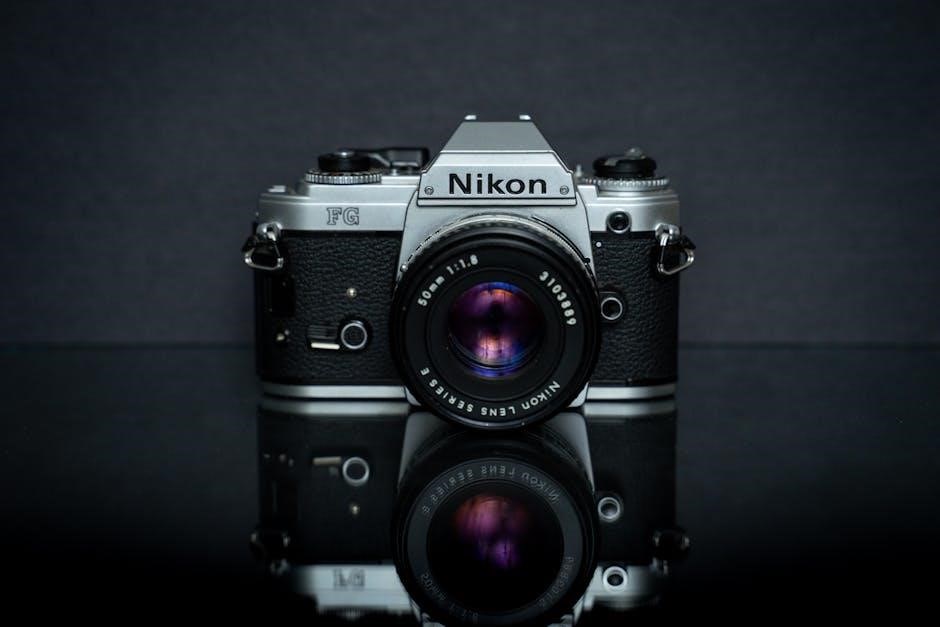
Advanced Shooting Modes and Settings
Explore advanced modes like Aperture Priority (A/Av), Shutter Priority (S/Tv), and Manual Exposure (M) for precise control over your photography. Customize settings to refine your creative vision.
Aperture Priority Mode (A/Av)
Aperture Priority Mode (A/Av) offers precise control over aperture, letting you dictate depth of field while the camera adjusts shutter speed automatically. Ideal for portraits and landscapes, this mode allows creative flexibility in managing light and focus. Use the command dial to set your desired aperture, and the D70 will optimize exposure by adjusting the shutter speed. This mode is perfect for photographers who prioritize depth of field and want to achieve professional-looking results with ease. Experiment with different apertures to master various effects and enhance your photography skills effectively. This feature is a cornerstone of advanced digital photography techniques.
Shutter Priority Mode (S/Tv)
Shutter Priority Mode (S/Tv) lets you control shutter speed while the camera automatically adjusts aperture for optimal exposure. This mode is ideal for capturing motion, such as freezing fast-moving subjects or creating artistic blur. Use the command dial to set your desired shutter speed, and the D70 will adjust the aperture accordingly. Faster speeds are great for sports and action, while slower speeds create creative effects like motion blur. This mode offers a balance between creative control and automatic convenience, making it perfect for experimenting with dynamic photography techniques. Mastering Shutter Priority Mode enhances your ability to capture life’s fleeting moments with precision and artistry.
Manual Exposure Mode (M)
Manual Exposure Mode (M) provides full control over both shutter speed and aperture, allowing you to fine-tune settings for precise results. Use the command dial to adjust shutter speed and aperture independently, with the exposure compensation button for further refinements. The camera displays an exposure level indicator in the viewfinder to help you achieve optimal exposure. This mode is ideal for experienced photographers who want to override automatic settings. It offers complete creative control, enabling you to capture images exactly as envisioned. Experiment with different combinations to master challenging lighting conditions and techniques, ensuring every shot meets your artistic vision. Mastery of Manual mode unlocks the D70’s full potential.
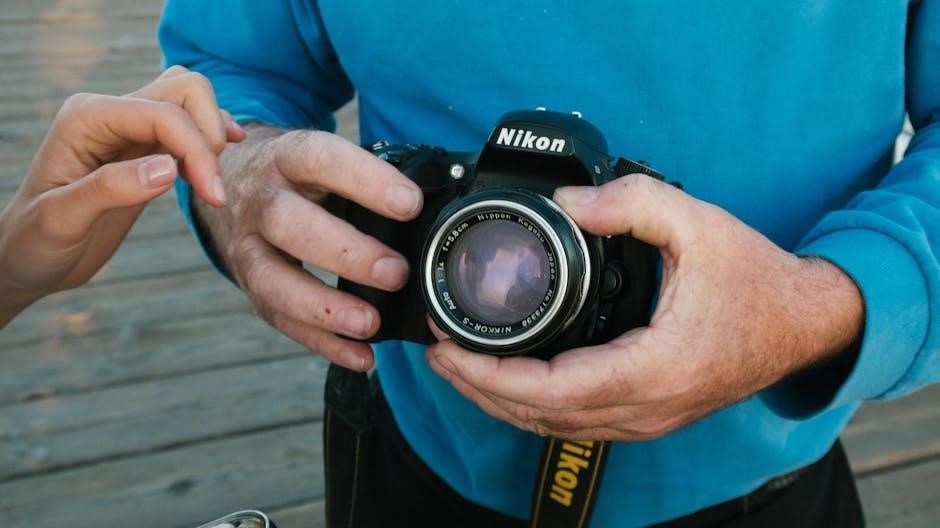
Image Quality and Optimization
Optimizing image quality on the Nikon D70 involves adjusting ISO settings, white balance, and color modes to suit lighting conditions. Use lower ISOs for reduced noise and sharper images. Adjusting white balance ensures accurate colors, while customizing color modes enhances saturation and contrast. Proper file formatting and lens selection further refine photo quality, ensuring vibrant and professional results. Mastering these settings allows you to capture stunning images with precision and creativity, making the most of the D70’s capabilities.
Adjusting ISO Settings for Different Lighting Conditions
Adjusting ISO settings on the Nikon D70 is crucial for optimal image quality in various lighting conditions. In low-light scenarios, higher ISOs (e.g., ISO 1600) help capture brighter images, but may introduce noise. In bright conditions, lower ISOs (e.g., ISO 200) preserve detail and minimize grain. For indoor photography, ISO 400-800 often strikes a balance. The D70’s ISO AUTO feature can simplify adjustments, but manual control ensures precision. Always aim to use the lowest ISO necessary for the scene to reduce noise and enhance sharpness. Experiment with settings to find the ideal balance for your shots, ensuring vibrant and clear results.
Understanding White Balance and Preset Options
White balance on the Nikon D70 ensures accurate color representation by adjusting to lighting conditions. Preset options like Auto, Daylight, Shade, and Fluorescent help match the scene’s color temperature. For precise control, use the WB button to select from these modes or set a custom white balance (PRE) by scrolling through options. This feature is especially useful for capturing true-to-life colors in challenging lighting. By mastering white balance, you can enhance image quality and achieve professional-grade results with minimal post-processing. Experiment with different settings to find the perfect balance for your shots, ensuring vibrant and natural hues in every photo.
Customizing Color Modes and Saturation
The Nikon D70 allows you to customize color modes and saturation to tailor your images to your creative vision. Access the Shooting Menu and select “Optimize Image” to choose from options like Standard, Vivid, and More Vivid. Adjust saturation levels to enhance or mute colors, with settings ranging from -5 to +5. For precise control, use the Custom option to set saturation and color mode preferences. This feature is ideal for capturing vibrant landscapes or subtle portraits. Experiment with these settings to achieve the desired aesthetic, ensuring your photos reflect your artistic intent with rich, dynamic colors tailored to your style.
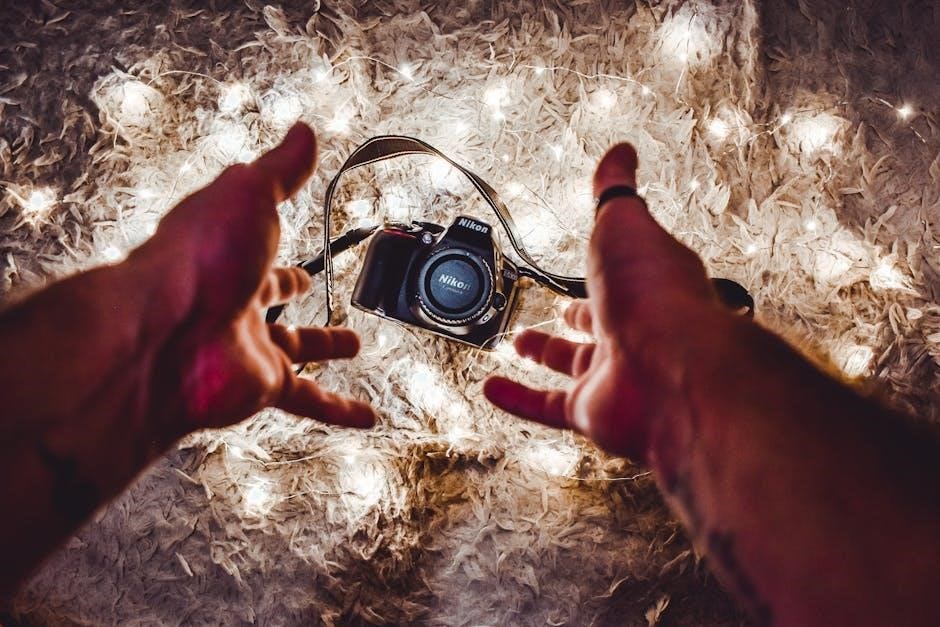
Additional Camera Features
Customize the Nikon D70’s color modes and saturation to enhance your photos. Access the Shooting Menu, select “Optimize Image,” and choose from options like Standard, Vivid, and More Vivid. Adjust saturation levels from -5 to +5 to mute or amplify colors, perfect for vibrant landscapes or subtle portraits. Use the Custom setting for precise control, tailoring color modes and saturation to match your artistic vision and capture images with rich, dynamic colors.
Using the Built-In Flash and External Flash Options
The Nikon D70 features a built-in flash with a guide number of 15, ideal for fill lighting in daylight or illuminating subjects in low light. It supports i-TTL flash metering for precise exposure control. For added versatility, the camera is compatible with Nikon Speedlights via the hot shoe mount. External flash units like the SB-800 and SB-600 offer advanced features such as wireless operation and more power. To use the built-in flash, press the flash button on the front to pop it up and select the desired mode via the menu. For external flashes, attach them to the hot shoe and sync settings automatically. This system provides flexibility for creative lighting solutions, enhancing your photography experience with the D70.
Autofocus Modes and AF Area Selection
The Nikon D70 offers advanced autofocus capabilities, featuring a Multi-CAM 1000 AF sensor with 5 focus points. It supports Single AF (AF-S) for stationary subjects and Continuous AF (AF-C) for moving subjects. The AF area can be selected manually or set to automatic mode. Dynamic Area AF allows the camera to track subjects across focus points, while Group Dynamic AF focuses on a cluster of points. These modes enhance accuracy and flexibility, enabling precise control over focus acquisition. Customizing AF settings ensures optimal performance for various shooting scenarios, making the D70 versatile for capturing sharp images in diverse conditions.
Custom Settings and User-Defined Controls
The Nikon D70 allows users to tailor camera functions to their preferences through custom settings. Accessible via the menu, these options enable personalized control over shooting parameters, such as button assignments and exposure adjustments. Custom settings streamline workflows, allowing photographers to quickly access frequently used functions. For instance, users can assign specific roles to buttons or define default settings for various shooting modes. This feature enhances efficiency and adaptability, making the D70 more intuitive for individual shooting styles. By leveraging custom settings, photographers can optimize their camera setup for consistent and professional results in diverse photographic situations.
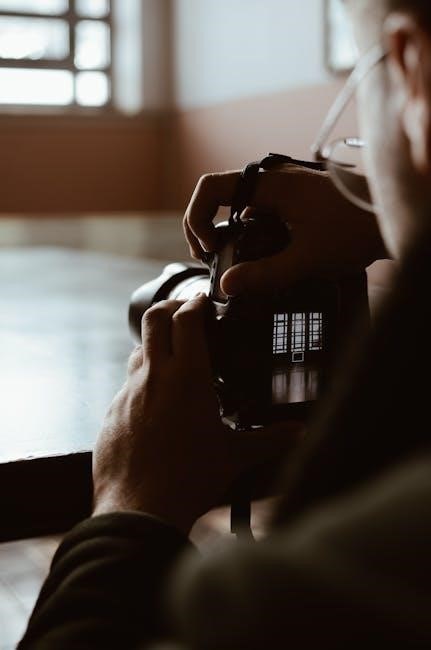
Maintenance and Care
Regular maintenance ensures the Nikon D70’s longevity and optimal performance. Clean the image sensor and mirror, protect from dust, and use a dry cloth for the exterior. Store the camera in a cool, dry place to preserve functionality.
Cleaning the Image Sensor and Mirror
Cleaning the image sensor and mirror is crucial for maintaining image quality. Use a hand pump blower to remove dust from the sensor. For stubborn spots, dampen a microfiber cloth with distilled water, but avoid touching the sensor. Clean the mirror with a dry cloth, as liquids can damage it. Set the camera to Mirror Lock-Up mode before cleaning. Regularly inspect and clean the sensor to prevent dust spots in images. For detailed steps, refer to the manual. Avoid using household cleaners, as they may damage the camera. If unsure, consider professional cleaning to ensure optimal performance and longevity of your Nikon D70.
Protecting the Camera’s Exterior and Accessories
To maintain your Nikon D70’s condition, use a high-quality camera bag or case to shield it from scratches and impacts. Always attach the lens cap when the lens is not in use to prevent dust and damage. For added protection, consider a rain cover when shooting in wet conditions. Avoid exposing the camera to harsh chemicals or extreme temperatures. Clean the exterior with a soft, dry cloth, and avoid touching the lens surfaces. Store the camera in a cool, dry place away from direct sunlight. Regularly inspect and clean accessories like tripods and straps to ensure optimal functionality and longevity of your equipment.
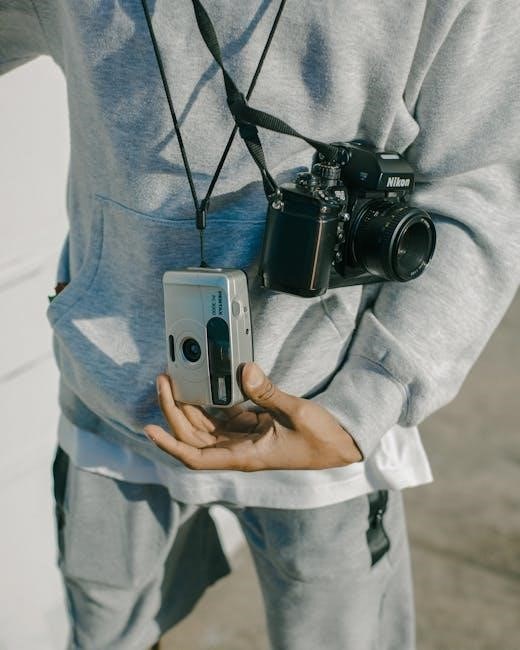
Troubleshooting Common Issues
Identify and resolve common issues like error messages, focusing problems, or memory card errors by resetting settings, cleaning the sensor, and ensuring proper lens and card usage.
Resolving Error Messages and Camera Malfunctions
When encountering error messages or malfunctions, refer to the Nikon D70 manual for specific solutions. Common issues include lens errors or memory card problems. Resetting the camera by pressing and holding the QUAL and /- buttons can often resolve these. Clean the image sensor regularly to prevent dust-related errors. For firmware-related issues, update to the latest version using Nikon’s software. Always ensure proper battery power and check for loose connections. If problems persist, consult the troubleshooting guide or contact Nikon support for assistance. Regular maintenance and proper handling can prevent many common malfunctions.
Fixing Common Problems with Autofocus and Exposure
To address autofocus issues on your Nikon D70, ensure the lens is clean and properly attached. Check the AF mode settings, as using the wrong mode can cause focusing problems. For exposure issues, verify that the metering mode matches your shooting conditions. Adjust ISO settings carefully to avoid noise, especially in low-light situations. Incorrect white balance can also affect image quality, so ensure it’s set appropriately. Regularly clean the image sensor to prevent dust interference. If problems persist, consider updating the camera’s firmware to resolve any software-related glitches. Consulting the manual or online forums can provide additional troubleshooting guidance.
